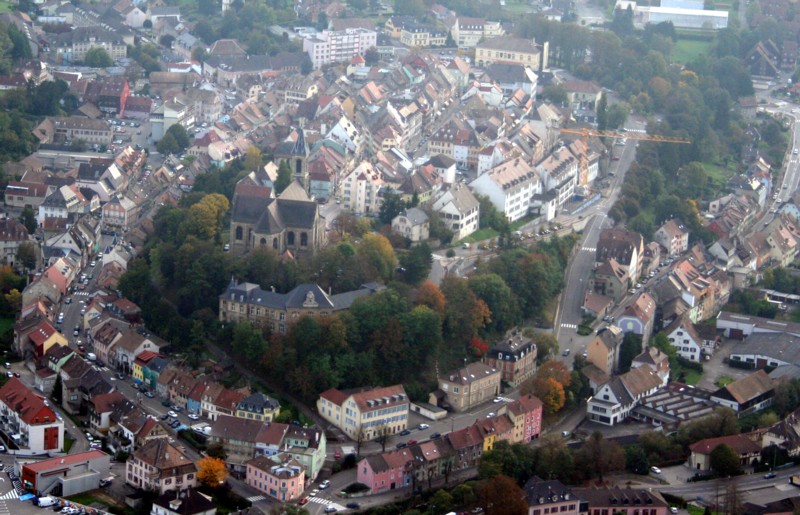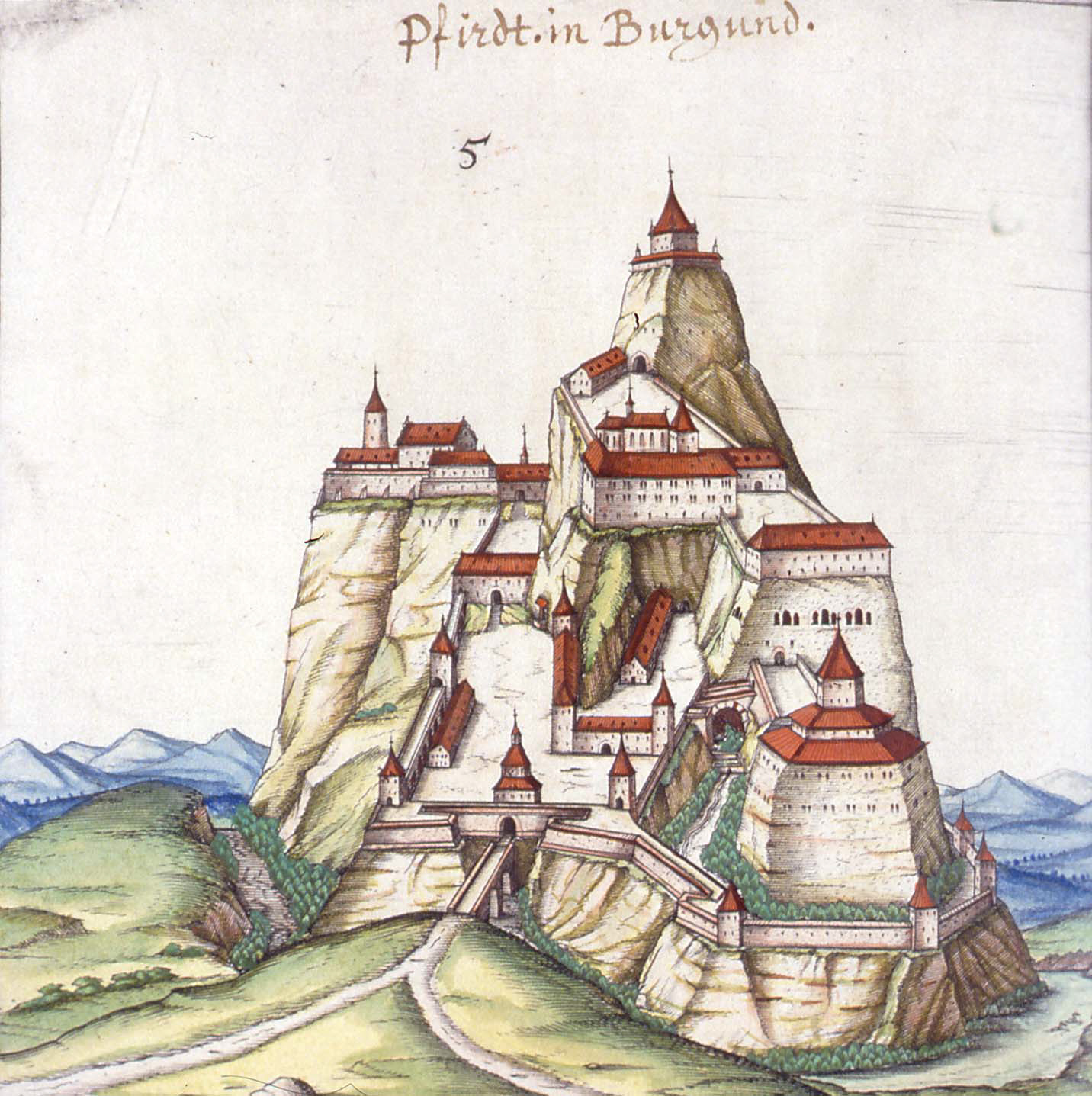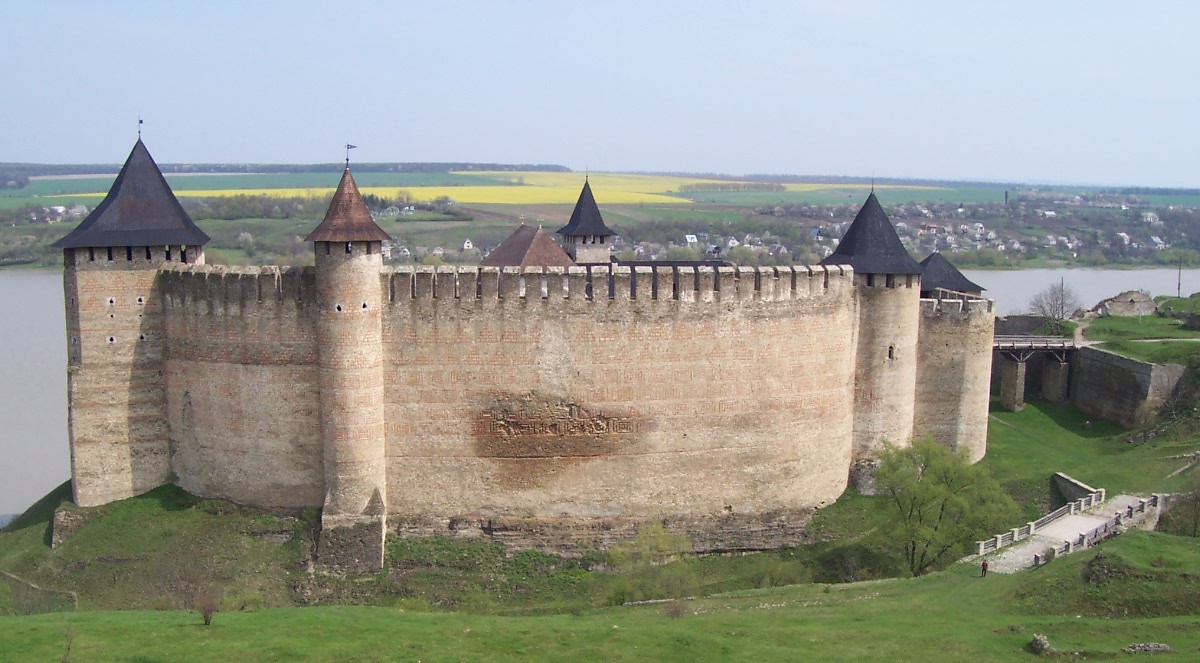|
Château D'Altkirch
The Château d'Altkirch was a castle, now destroyed, in the '' commune'' of Altkirch in the Haut-Rhin ''département'' of France. History The castle was built by the counts of Ferrette who lived at Altkirch in the 11th centuryWilsdorf, C ''Histoire des comtes de Ferrette'', 1991, p. 29-37 The castle could have been built in the 12th century or at the start of the 13th: its first documented mention is from 1231. The discovery of 15th century documents from Milan has prompted several authors to say that the keep only dates from the 15th century. Situated on the edge of a spur overlooking the valley of the River Ill, the castle lost its strategic importance in the 16th century and slowly declined. After 1659, the owners ( Mazarin and his heirs) showed little interest in the structure and some external buildings were put aside (prison, keeper's house). The keep was still standing in 1844 along with some sections of wall. The whole site was cleared in 1855-45 during the construction o ... [...More Info...] [...Related Items...] OR: [Wikipedia] [Google] [Baidu] |
Castle
A castle is a type of fortified structure built during the Middle Ages predominantly by the nobility or royalty and by military orders. Scholars debate the scope of the word ''castle'', but usually consider it to be the private fortified residence of a lord or noble. This is distinct from a palace, which is not fortified; from a fortress, which was not always a residence for royalty or nobility; from a ''pleasance'' which was a walled-in residence for nobility, but not adequately fortified; and from a fortified settlement, which was a public defence – though there are many similarities among these types of construction. Use of the term has varied over time and has also been applied to structures such as hill forts and 19th-20th century homes built to resemble castles. Over the approximately 900 years when genuine castles were built, they took on a great many forms with many different features, although some, such as curtain walls, arrowslits, and portcullises, wer ... [...More Info...] [...Related Items...] OR: [Wikipedia] [Google] [Baidu] |
Communes Of France
The () is a level of administrative division in the French Republic. French are analogous to civil townships and incorporated municipalities in the United States and Canada, ' in Germany, ' in Italy, or ' in Spain. The United Kingdom's equivalent are civil parishes, although some areas, particularly urban areas, are unparished. are based on historical geographic communities or villages and are vested with significant powers to manage the populations and land of the geographic area covered. The are the fourth-level administrative divisions of France. vary widely in size and area, from large sprawling cities with millions of inhabitants like Paris, to small hamlets with only a handful of inhabitants. typically are based on pre-existing villages and facilitate local governance. All have names, but not all named geographic areas or groups of people residing together are ( or ), the difference residing in the lack of administrative powers. Except for the municipal arr ... [...More Info...] [...Related Items...] OR: [Wikipedia] [Google] [Baidu] |
Altkirch
Altkirch (, ; gsw, label= Alsatian, Àltkìrech) is a commune in the Haut-Rhin department in Alsace in north-eastern France. The town is traditionally regarded as the capital of Sundgau. Etymology The name of the commune means ''old church'' ( gsw-FR, Àlta Kìrch or ''Àlta Kìrech''; german: Alte Kirche). History In the 1370s, the citizens of Altkirch made battle and won against a company of Gugler mercenaries. Demography Its inhabitants are known as ''Altkirchois''. The resident population number of 5500 is rather deceptive as some 15,500 people will be in town on a typical working day (4500 working, 3000 studying, 3000 for medical treatment and another 5000 divided between shopping, administrative offices, cultural and sporting activities). Sister cities *Azerbaijan (Nagorno-Karabakh) Füzuli (2016) See also * Château d'Altkirch - destroyed castle in the town. * Communes of the Haut-Rhin department The following is a list of the 366 communes of the French ... [...More Info...] [...Related Items...] OR: [Wikipedia] [Google] [Baidu] |
Haut-Rhin
Haut-Rhin (, ; Alsatian: ''Owerelsàss'' or '; german: Oberelsass, ) is a department in the Grand Est region of France, bordering both Germany and Switzerland. It is named after the river Rhine. Its name means ''Upper Rhine''. Haut-Rhin is the smaller and less populated of the two departments of the former administrative Alsace region, the other being the Bas-Rhin ( Lower Rhine). Especially after the 1871 cession of the southern territory known since 1922 as Territoire de Belfort, although it is still densely populated compared to the rest of metropolitan France. It had a population of 767,086 in 2019.Populations légales 2019: 68 Haut-Rhin INSEE On 1 January 2021, the departments of Bas-Rhin and Haut-Rhi ... [...More Info...] [...Related Items...] OR: [Wikipedia] [Google] [Baidu] |
Departments Of France
In the administrative divisions of France, the department (french: département, ) is one of the three levels of government under the national level ("territorial collectivities"), between the administrative regions and the communes. Ninety-six departments are in metropolitan France, and five are overseas departments, which are also classified as overseas regions. Departments are further subdivided into 332 arrondissements, and these are divided into cantons. The last two levels of government have no autonomy; they are the basis of local organisation of police, fire departments and, sometimes, administration of elections. Each department is administered by an elected body called a departmental council ( ing. lur.. From 1800 to April 2015, these were called general councils ( ing. lur.. Each council has a president. Their main areas of responsibility include the management of a number of social and welfare allowances, of junior high school () buildings and technical ... [...More Info...] [...Related Items...] OR: [Wikipedia] [Google] [Baidu] |
Counts Of Ferrette
The County of Ferrette (or Pfirt) was a feudal jurisdiction in Alsace in the Middle Ages and the early modern period. It roughly corresponds with the Sundgau and comprised the lordships of Ferrette (Pfirt), Altkirch, Thann, Belfort, Rougemont and others. These territories were not contiguous, but formed a patchwork of jurisdictions under the Holy Roman Empire.Richard Vaughan, ''Charles the Bold: The Last Valois Duke of Burgundy'' (Boydell, 1973), pp. 86–88. The County of Ferrette emerged in the twelfth century alongside the County of Montbéliard as a division of the '' pagus'' of Elsgau, traditionally regarded as the southernmost ''pagus'' of Alsace.Tom Scott, ''Regional Identity and Economic Change: The Upper Rhine, 1450–1600'' (Clarendon, 1999), p. 29. This was a Francophone region. In the late Middle Ages, the County of Ferrette was the most westerly Habsburg possession and a part of Further Austria. It bordered the French Duchy of Burgundy and all four dukes o ... [...More Info...] [...Related Items...] OR: [Wikipedia] [Google] [Baidu] |
Keep
A keep (from the Middle English ''kype'') is a type of fortified tower built within castles during the Middle Ages by European nobility. Scholars have debated the scope of the word ''keep'', but usually consider it to refer to large towers in castles that were fortified residences, used as a refuge of last resort should the rest of the castle fall to an adversary. The first keeps were made of timber and formed a key part of the motte-and-bailey castles that emerged in Normandy and Anjou during the 10th century; the design spread to England, south Italy and Sicily. As a result of the Norman invasion of 1066, use spread into Wales during the second half of the 11th century and into Ireland in the 1170s. The Anglo-Normans and French rulers began to build stone keeps during the 10th and 11th centuries; these included Norman keeps, with a square or rectangular design, and circular shell keeps. Stone keeps carried considerable political as well as military importance and could tak ... [...More Info...] [...Related Items...] OR: [Wikipedia] [Google] [Baidu] |
Ill (France)
The Ill (; ) is a river in Alsace, in north-eastern France, and a left-bank, or western, tributary of the Rhine. It is long. It starts down from its source near the village of Winkel, Haut-Rhin, Winkel, in the Jura mountains, with a resurgence near Ligsdorf, turns around Ferrette on its east side, and then runs northward through Alsace, flowing parallel to the Rhine. Taking apart the Largue, also coming from the Jura mountains near Illfurth, it receives several tributaries from the west bank Vosges mountains after passing through Altkirch: the Doller (river), Doller in Mulhouse, the Thur (France), Thur near Ensisheim, the Lauch in Colmar, the Fecht (river), Fecht in Illhaeusern, the Giessen in Sélestat, the Andlau near Fegersheim, the Ehn near Geispolsheim, the Bruche (river), Bruche next to Strasbourg and the Souffel upstream from La Wantzenau before meeting with the Rhine downstream from Gambsheim's Lock (water transport), lock. As the Ill nears the city of Mulhouse, most of ... [...More Info...] [...Related Items...] OR: [Wikipedia] [Google] [Baidu] |
Cardinal Mazarin
Cardinal Jules Mazarin (, also , , ; 14 July 1602 – 9 March 1661), born Giulio Raimondo Mazzarino () or Mazarini, was an Italian cardinal, diplomat and politician who served as the chief minister to the Kings of France Louis XIII and Louis XIV from 1642 to his death. In 1654, he acquired the title Duke of Mayenne and in 1659 that of 1st Duke of Rethel and Nevers. After serving as a papal diplomat for Pope Urban VIII, Mazarin offered his diplomatic services to Cardinal Richelieu and moved to Paris in 1640. After the death of Richelieu in 1642, Mazarin took his place as first minister and then of Louis XIII in 1643. Mazarin acted as the head of the government for Anne of Austria, the regent for the young Louis XIV. Mazarin was also made responsible for the king's education until he came of age. The first years of Mazarin in office were marked by military victories in the Thirty Years' War, which he used to make France the main European power and establish the Peace of ... [...More Info...] [...Related Items...] OR: [Wikipedia] [Google] [Baidu] |
Indulgence
In the teaching of the Catholic Church, an indulgence (, from , 'permit') is "a way to reduce the amount of punishment one has to undergo for sins". The ''Catechism of the Catholic Church'' describes an indulgence as "a remission before God of the temporal punishment due to sins whose guilt has already been forgiven, which the faithful Christian who is duly disposed gains under certain prescribed conditions through the action of the Church which, as the minister of redemption, dispenses and applies with authority the treasury of the satisfactions of Christ and all of the saints". The recipient of an indulgence must perform an action to receive it. This is most often the saying (once, or many times) of a specified prayer, but may also include a pilgrimage, the visiting of a particular place (such as a shrine, church or cemetery) or the performance of specific good works. Indulgences were introduced to allow for the remission of the severe penances of the early church and gran ... [...More Info...] [...Related Items...] OR: [Wikipedia] [Google] [Baidu] |
Enceinte
Enceinte (from Latin incinctus: girdled, surrounded) is a French term that refers to the "main defensive enclosure of a fortification". For a castle, this is the main defensive line of wall towers and curtain walls enclosing the position. For a settlement, it would refer to the main town wall with its associated gatehouses, towers, and walls. According to the 1911 ''Encyclopædia Britannica'', the term was strictly applied to the continuous line of bastions and curtain walls forming "the body of the place", this last expression being often used as synonymous with ''enceinte''. However, the outworks or defensive wall close to the enceinte were not considered as forming part of it. In early 20th-century fortification, the enceinte was usually simply the ''innermost'' continuous line of fortifications. In architecture, generally, an enceinte is the close or precinct of a cathedral, abbey, castle, etc. This definition of the term differs from the more common use of enceinte ... [...More Info...] [...Related Items...] OR: [Wikipedia] [Google] [Baidu] |
List Of Castles In France
This is a list of castles in France, arranged by Region and Department. ;Notes: # The French word ''château'' has a wider meaning than the English ''castle'': it includes architectural entities that are properly called palaces, mansions or vineyards in English. This list focuses primarily on architectural entities that may be properly termed ''castle'' or ''fortress'' (french: château-fort), and excludes entities not built around a substantial older castle that is still evident. # Occasionally, where there is not a specific article on a castle, links are given to another article that includes details, typically an article on a town. # ''Italics'' indicate links to articles in the French Wikipedia. # If no article appears in either English or French Wikipedias, a link is given to an external website. # The number in parentheses after the name of each department indicates the department number used for administrative purposes. # The number of castles in France is estimated to abou ... [...More Info...] [...Related Items...] OR: [Wikipedia] [Google] [Baidu] |





